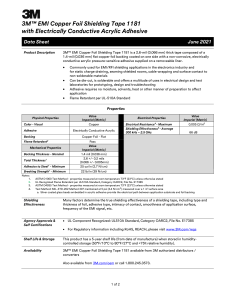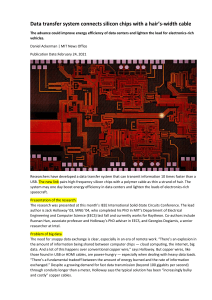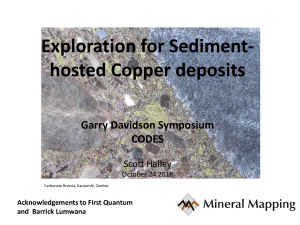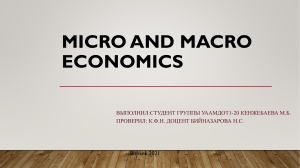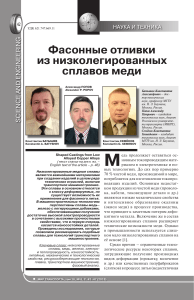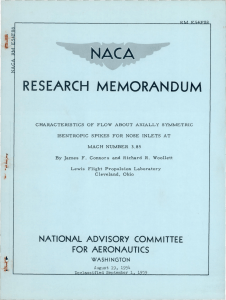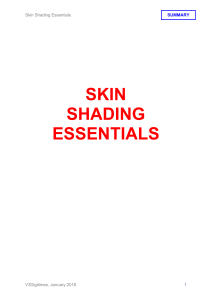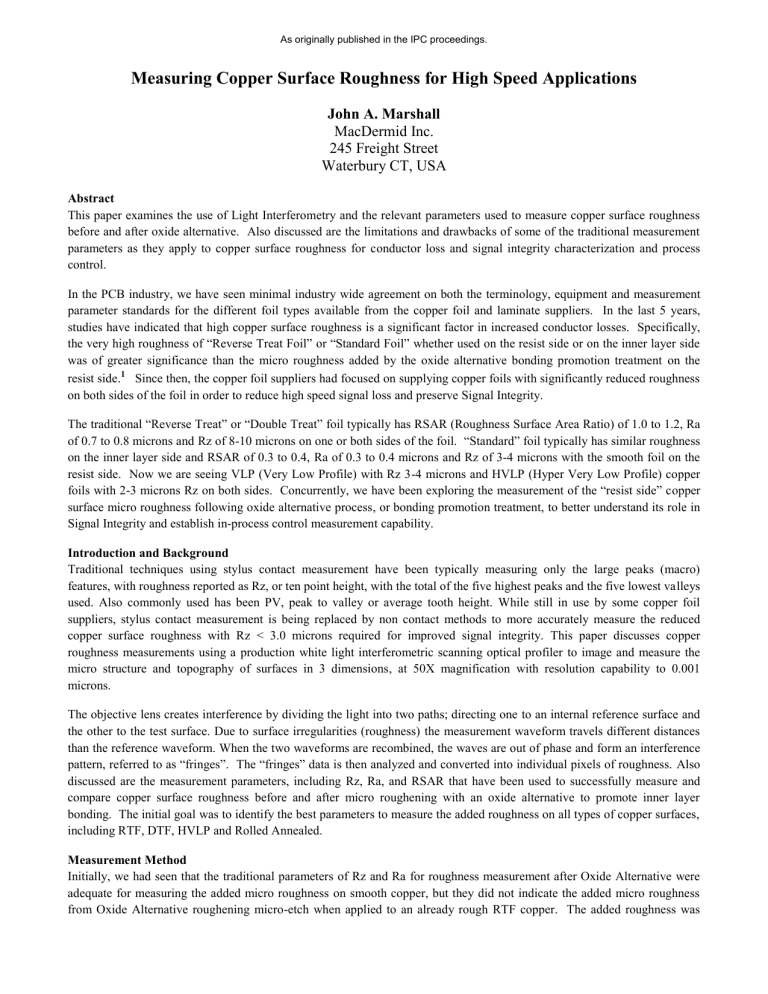
As originally published in the IPC proceedings. Measuring Copper Surface Roughness for High Speed Applications John A. Marshall MacDermid Inc. 245 Freight Street Waterbury CT, USA Abstract This paper examines the use of Light Interferometry and the relevant parameters used to measure copper surface roughness before and after oxide alternative. Also discussed are the limitations and drawbacks of some of the traditional measurement parameters as they apply to copper surface roughness for conductor loss and signal integrity characterization and process control. In the PCB industry, we have seen minimal industry wide agreement on both the terminology, equipment and measurement parameter standards for the different foil types available from the copper foil and laminate suppliers. In the last 5 years, studies have indicated that high copper surface roughness is a significant factor in increased conductor losses. Specifically, the very high roughness of “Reverse Treat Foil” or “Standard Foil” whether used on the resist side or on the inner layer side was of greater significance than the micro roughness added by the oxide alternative bonding promotion treatment on the resist side.1 Since then, the copper foil suppliers had focused on supplying copper foils with significantly reduced roughness on both sides of the foil in order to reduce high speed signal loss and preserve Signal Integrity. The traditional “Reverse Treat” or “Double Treat” foil typically has RSAR (Roughness Surface Area Ratio) of 1.0 to 1.2, Ra of 0.7 to 0.8 microns and Rz of 8-10 microns on one or both sides of the foil. “Standard” foil typically has similar roughness on the inner layer side and RSAR of 0.3 to 0.4, Ra of 0.3 to 0.4 microns and Rz of 3-4 microns with the smooth foil on the resist side. Now we are seeing VLP (Very Low Profile) with Rz 3-4 microns and HVLP (Hyper Very Low Profile) copper foils with 2-3 microns Rz on both sides. Concurrently, we have been exploring the measurement of the “resist side” copper surface micro roughness following oxide alternative process, or bonding promotion treatment, to better understand its role in Signal Integrity and establish in-process control measurement capability. Introduction and Background Traditional techniques using stylus contact measurement have been typically measuring only the large peaks (macro) features, with roughness reported as Rz, or ten point height, with the total of the five highest peaks and the five lowest valleys used. Also commonly used has been PV, peak to valley or average tooth height. While still in use by some copper foil suppliers, stylus contact measurement is being replaced by non contact methods to more accurately measure the reduced copper surface roughness with Rz < 3.0 microns required for improved signal integrity. This paper discusses copper roughness measurements using a production white light interferometric scanning optical profiler to image and measure the micro structure and topography of surfaces in 3 dimensions, at 50X magnification with resolution capability to 0.001 microns. The objective lens creates interference by dividing the light into two paths; directing one to an internal reference surface and the other to the test surface. Due to surface irregularities (roughness) the measurement waveform travels different distances than the reference waveform. When the two waveforms are recombined, the waves are out of phase and form an interference pattern, referred to as “fringes”. The “fringes” data is then analyzed and converted into individual pixels of roughness. Also discussed are the measurement parameters, including Rz, Ra, and RSAR that have been used to successfully measure and compare copper surface roughness before and after micro roughening with an oxide alternative to promote inner layer bonding. The initial goal was to identify the best parameters to measure the added roughness on all types of copper surfaces, including RTF, DTF, HVLP and Rolled Annealed. Measurement Method Initially, we had seen that the traditional parameters of Rz and Ra for roughness measurement after Oxide Alternative were adequate for measuring the added micro roughness on smooth copper, but they did not indicate the added micro roughness from Oxide Alternative roughening micro-etch when applied to an already rough RTF copper. The added roughness was As originally published in the IPC proceedings. visually apparent after SEM, but Ra and RZ measurements did not appear to accurately reflect the amount of added micro roughness after Oxide Alternative. We found that RSAR was capable of measuring the copper surface micro roughness after Oxide Alternative Process with both very rough RTF copper and very smooth HVLP copper. Through digital filtering of the test data, the surface characteristics of the test part can be broken down into waviness, roughness and high frequency results (Fig. 1). Selecting the appropriate filter settings has a significant bearing on the actual results, especially when measuring the micro roughness from the Oxide Alternative process. While the low frequency filter has shown to be very useful for removing surface waviness due to underlying glass weave impressions and any curvature of the sample, we have seen that using a high frequency filter removes a significant amount of the micro roughness that is visually apparent by SEM examination. Recently we have been using minimal low frequency filter setting of 50 and zero high frequency filter to preserve as much of the micro-roughness from the oxide alternative process as possible. The low filter setting has almost no effect on Rz, Ra, and RSAR Figure 1 – Data Filtering With many different Roughness Measurement parameters to choose from, we initially focused on three basic measurement parameters: Rz, Ra, and RSAR. Rz, also referred to as Ten point height, is the average absolute value of the five highest peaks and the five lowest valleys, measured in microns. Rz = (P1 + P2…P5) – (V1 = V2…V5) / 5. (Fig. 2) We found the Rz data typically has the highest variation of all the parameters used, being influenced by any surface scratches and non-uniformity within the measurement area. Rz is useful for measuring overall maximum macro surface roughness, large features. On a perfectly uniform surface, Rz would equal 10X the Ra, with higher Rz : Ra indicating increased non-uniformity. Figure 2 – Rz Ra is defined as average surface roughness, or average deviation, of all points from a plane to fit the surface, measured in microns. On a perfectly uniform surface, the average peak to valley height would be 2X the Ra value. (Fig. 3) As originally published in the IPC proceedings. Figure 3 - Ra Both Rz and Ra are useful to measure the macro roughness of the larger features before and after Oxide Alternative microetch. (Fig. 4) RSAR is the ratio of roughness surface area to the planar area occupied by the data, as illustrated below. (Fig. 5) Figure 5. RSAR measures the increase in 3 dimensional roughness relative to the 2 dimensional area it occupies and has proved to be most useful for measuring the micro roughness imparted by the oxide alternative process, especially on previously roughened surfaces including RTF copper. (Fig. 6) Figure 4 – Macro roughness Figure 6 – Micro roughness It was readily apparent on VLP smooth foil that all four parameters used provided accurate measurement of the increase in micro-roughness from oxide alternative. However, on RTF copper only the RSAR measurement indicated an increase (shown in green) of the micro-roughness. Interestingly, with the RTF rough copper, the Ra, Rz and Rq values were reduced, indicating some “smoothing” of the peaks through oxide alternative process. These results also indicated the neglible impact of minimum filter settings on the parameters measured, with Rz showing the biggest change. (Table 1) As originally published in the IPC proceedings. RTF Cu Start After OA Ra 1.45 1.35 Table 1 – RTF and VLP Copper No Filters Filter – High 0.6/ Low 500 RSAR Rq Rz Ra RSAR Rq 1.56 1.78 11.28 1.48 1.59 1.78 2.15 1.69 11.62 1.37 1.97 1.69 VLP Cu Start After OA Ra 0.29 0.49 RSAR 0.30 1.35 Rq 0.38 0.62 Rz 3.77 8.26 Ra 0.29 0.48 RSAR 0.30 1.15 Rq 0.37 0.6 Rz 11.07 10.82 Rz 3.1 6.74 Two and three Band maps of the copper surface roughness (Fig. 9 and Fig. 10) show the waviness removed by the low filter on the lower left and right scan map and the high frequency “noise” removed by the high filter on the upper left scan map. In comparison, the two band map (Fig. 10) only removed the substrate waviness and preserved all other data as “micro” roughness which compares well with the actual significant roughness observed by SEM. (Fig 11 and Fig. 12) HF noise or real roughness? Figure 9 – Three Band Map Figure 11 – Before Oxide Alternative Figure 10 - Two Band Map Figure 12 – After Oxide Alternative Samples of 6 different materials were measured by the production Light Interferometry after Develop, Etch and Strip and following Oxide Alternative process. For comparison, one sample of each material was not processed through Develop, Etch and Strip before Oxide Alternative process. The results after DES show that two of the six materials (#2 and #4) had some side to side variation in roughness. With the smooth copper, most of the variation was removed by the oxide alternative micro-etch leaving both sides with similar roughness. The RTF copper however, still had significant side to side variation after oxide alternative. As originally published in the IPC proceedings. The average gain in roughness after oxide alternative oxide was calculated, with the HTE and HVLP smooth copper samples having similar results. The RTF copper sample #3 was slightly lower, while the RTF #4, with high side to side variation, had the highest increase of all samples measured. (Table 2) Table 2 – Roughness Gain after Oxide Alternative 1 2 3 4 5 6 HTE - A HTE - B RTF - A RTF - B HVLP - A HVLP - B Rz Ra Rq RSAR 3.04 3.22 1.52 1.464 3.25 2.99 0.186 0.214 0.127 0.036 0.212 0.174 0.23 0.22 0.075 -0.03 0.266 0.219 0.824 0.848 0.697 1.2 0.866 0.865 During the past five years we have gained a better understanding that the very high roughness of the RTF, or “Standard” copper foil, was the most significant factor in high speed signal loss, with inner layer side roughness becoming increasingly more significant as signal speed exceeds 10 GHz.2 Historically, we have seen higher variation in roughness of RTF or DSTF copper and increased roughness at higher copper weights. Overall, the Signal Integrity results have reversed the trend towards RTF copper for increased bonding integrity following the conversion to “lead free” assembly conditions. With that understanding, we have seen new copper foil products introduced with significantly reduced roughness on both the inner layer side and the resist side.3 (Table 3) There has been a growing trend away from the “standard” RTF copper found on both sides of the foil. Many customers have been successful in producing PCBs with up to and above 13 GHz by careful choice of the appropriate material combined with low profile copper foil and reduced oxide alternative etch rate. We have also seen that controlling the etch rate and the chemical conditions in the oxide alternative process are critical in maximizing conductor profile and in reducing the conductor roughness to optimize signal integrity. PCB fabricators are now focusing more on the “resist side” copper starting roughness, in-process micro-etch and “fine tuning” the conductor roughness after oxide alternative bonding promotion treatment. Table 3 – Typical Inner Layer Resist Side Roughness Resist Side STD (RTF) VLP (HTE) HVLP After Alt. Oxide STD (RTF) VLP (HTE) HVLP Ra RSAR Rq Rz 0.6 - 1.5 0.3 - 0.35 0.25 - 0.3 0.7 - 1.5 0.3 - 0.4 0.2 - 0.3 1.0 - 2.0 0.3 - 0.4 0.25 -0.35 7.0 - 12.0 3.0 - 4.0 2.0 - 3.0 Ra RSAR Rq Rz 0.7 - 1.4 0.45 - 0.6 0.4 - 0.5 1.2 - 2.2 0.8 - 1.5 0.7 - 1.3 1.0 - 2.0 0.6 - 1.0 0.5 - 0.7 7.0 - 12.0 6.0 - 8.0 4.0 - 6.0 Measurement Parameter Limitations With a wide choice of parameters available for conductor surface roughness measurement, we find the most effective are: Rz to define maximum roughness, RA to define overall average macro roughness and RSAR to define the micro-roughness from the oxide alternative process. However, as we saw when measuring micro-roughness on previously roughened copper, there would appear to be limitations with utilizing some of those measurement parameters into signal loss predictions, especially in surfaces with non-homogenous roughness. While Ra provides a good description of the average roughness of a uniform surface it does have some limitations as shown below. These two examples below have the same Ra, but not the same conductor length and not the same RSAR. They could well have different signal losses, depending on signal frequency and the actual circuit dimensions. (Fig. 13) As originally published in the IPC proceedings. Rz Ra Rz Ra Rz Ra Ra Ra Rz Rz Fig. 13 - These Surfaces have the same Ra and the same Rz Rz measurements typically have greater variation than other parameters, due in part to the measurement of only the five highest peaks and the five lowest valleys. Rz measurements are influenced by surface scratches and typically have the highest variation. All the surfaces shown have the same Rz, but not the same surface length. (Fig 14) Rz Rz Rz Rz Rz Rz Fig. 14 – These surfaces have the same Rz Conclusions We have found that using Light Interferometry Surface Roughness Measurement provides Ra, RSAR and Rz measurements for controlling inner layer copper roughness before lamination to assure in range condition of pre-established conductor losses. RSAR is the most useful for providing accurate data of the smaller (micro roughness) features imparted by the oxide alternative process or other chemical roughening processes and Ra measurements provide accurate data of the larger (macro roughness) features. Rz measurement only shows the maximum surface roughness and can be somewhat misleading, having sensitivity to any scratches or surface defects. However Rz is helpful in assessing overall non-uniformity by the relationship with Ra. Additionally, Rz can be measured by cross-section of the inner layer side of the foil to provide an “As received” record of the previously laminated foil side. We have seen the correct preparation (grinding and polishing) of cross-sections to be critical in obtaining reasonably accurate Rz numbers of the macro-roughness. Determination of the gain in surface roughness through Oxide Alternative process, before lamination, can provide process control data through the process. Additionally, the program provides Standard Deviation and Coefficient of Variation % data for SPC. Analyzing the raw measurement data with no reduction in micro roughness from high frequency filtering and minimal low filtering, provides accurate, optimized measurements of the copper surface. RSAR and Ra together provide an accurate measured representation of the micro roughened copper surface following Oxide Alternative Process and are suitable for process control. References 1. Effect of Conductor Surface Roughness upon Measured Loss and Extracted Values of PCB Laminate Dissipation factor. Scott Hinaga, Cisco Systems Feb 2, 2010. 2. 3. Insertion Loss Reduction through Non-Roughening Inner layer Surface Treatment. Scott Hinaga, Cisco Systems, March 25, 2014. Signal Transmission Loss due to Copper Surface Roughness in High Frequency Region. Elaine Lew, Mitsui Copper Foil Malaysia.
